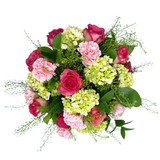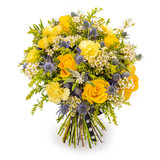24th Mar 2020
Flowers and Grammar Have a Strained Relationship
Reading about flowers and plants often leaves you in a grammatical puzzle. Some flower names are capitalised, some not; and plurals seem to be there at times, and sometimes not. What is the secret behind what is written how; and where is a plural appropriate, and where not?
If you have to write about flowers, then some rules will help. None of these rules is set in stone, so don’t be afraid to break them if it seems appropriate for a reason. But knowing that these rules exist sometimes helps you reading a text which otherwise might seem a bit cryptic. And all this is not yet touching on pronunciation, because you’ll find differences there, too.
Capitalisation in flower names is the easiest rule to remember, and one of the hardest to follow. If you combine a Freesia with a hydrangea, a Gerbera, and a gladiolus, what do you get? Don’t say a mess, because there is system in the madness. Capitalisation of flower names follows the usual grammatical rules with the exception of one group of names. If the common name for a flower is referring to a given name of a person or a place, then it is capitalised.
One beautiful flower has two common names: It is called bird of paradise on one hand, and Strelitzia on the other. The bird of paradise is spelled in lowercase all the way through as paradise does not refer to or is derived from the actual place; Strelitzia on the other hand is capitalised because the name was taken from the German Duchy of Mecklenburg-Strelitz in honour of Queen Charlotte of the United Kingdom (1744 to 1818). She was born a Princess in that duchy and a keen botanist and patron of Kew Gardens.
In my question, you find two other capitalised names, Freesia and Gerbera. The Freesia was named after the German physician Friedrich Heinrich Theodor Freese (1795 to 1868); the Gerbera got its name in honour of German physician and botanist Traugott Gerber (1710 to 1743). The Gerbera in British English is pronounced with a g as in garden, while in American English the pronunciation has been equalised with gerbil.
As you see, the rule is quite easy; you just need to know how the flower came by its name. And that is the difficult part to remember.
Once you solved the problem of the capitalisation, you would probably want to talk about more than one flower. A single Gerbera is certainly nice enough, but it takes several to make a nice bouquet. Let’s collect some Gerberas, Freesias, hydrangeas, and camellias to make a bouquet. The English plural with an s is correct for all of them while using the Latin plural would be correct, but sounds odd. The exception is gladioli where the Latin plural is correct and better to use than gladioluses.
Gladioli brought forth a curious linguistic phenomenon anyhow. Because most flower names seem to end in an a and gladioli sounds similar to gladiolae, the second and wrong spelling may be found quite often. It has been used so many times, in fact, that there are writers who use gladiola as a singular noun for the gladiolus.
Finally, there is the puzzle of seeming uses of the singular Gerbera, for instance, when referring to a multitude of flowers. A shop might offer a broad selection of Gerbera. The shop, in that case, offers a broad selection of flowers of the genus Gerbera, not just Gerberas of different colour. Whenever referring to the genera of flowers, the use is singular because there is only one genus of Gerbera. A genus is not, however, a mass noun.














